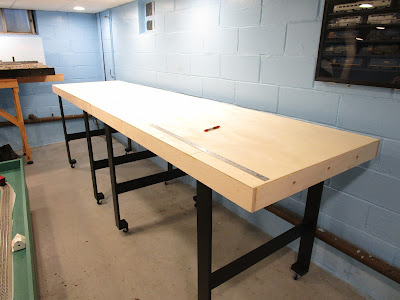There are several good reasons to use thick plywood for layout baseboard construction, though it comes at the tremendous cost of money and weight. Another school of thought advocates for 1" or 2" insulation foam (pink or blue) alone as a baseboard, but that has its drawbacks too such as it is tough to mount things to the underside of it and trains running on it can be noisy.
I wanted my layout sections to be lightweight, relatively strong, and easily modified for scenery. I don't need my layout to support my weight and I don't plan to walk on it. Nor am I concerned about it sagging between the cross braces. So, I went with a combination approach: plywood and foam.
The first layer is some thin sanded 1/4" plywood. This ties the wood framing materials together and it easily bonds to the top of open-grid benchwork with wood glue. So, after going to several big box stores to purchase plywood (it took several to find a store with a working saw to cut it 3'x6' so that it would fit in my car) I brought it home. I laid it on top of the my benchwork and marked the location of the joists with yardstick.
Then, I applied a layer of wood glue to the top of every joist and around the edges and set the plywood on top, being careful not to slide it around or it would squeeze the wood glue out of the joints. Finally, I used 1" long panel nails to hold everything until the glue fully set. I didn't use screws because they would require pre-drilling every hole or else run the risk of splitting the plywood box frame.
The only casualty was a brand new T-shirt that got wood glue on it when I leaned over the benchwork to nail on the far side.
No matter how I skewed it, the plywood wasn't a perfect rectangle and it extended slightly over the benchwork edge. This could cause interference with future layout sections and it had to be removed. A power sander would make quick work of it but I didn't want to get sawdust all over everything. So, I clamped my yardstick to the edge and used a utility knife to cut away the offending plywood. Since it was only 1/4" thick, it was easy.
Next to come is the foam.



No comments:
Post a Comment